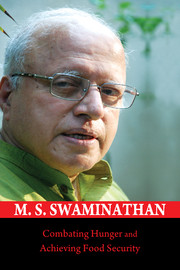Book contents
- Frontmatter
- Contents
- Foreword
- Preface
- Acknowledgements
- Abbreviations
- 1 Genesis and Growth of the Yield Revolution in Wheat
- 2 Our Agricultural Heritage
- 3 Shaping Our Agricultural Destiny
- 4 Thrust on Farm Revival
- 5 Nutri-farm Movement
- 6 Nutrition-sensitive Agriculture
- 7 Food Losses and Food Waste
- 8 Rice in Zero Hunger Challenge
- 9 Monsoon Management
- 10 Importance of Ecological Conservation
- 11 Caring for Ecology and Heritage
- 12 Conserving Biodiversity
- 13 Overcoming Hidden Hunger through Aquaculture
- 14 Biofuels – The Way to Go
- 15 Food Security
- 16 Vigilance for Sustainable Food Security
- 17 Food Security and Social Protection
- 18 Food Security and its Role
- 19 Sustaining the Livestock Revolution
- 20 Challenges in the Year of Science
- 21 Agriculture and Humanism
- 22 Fostering the Science of Science Communication
- 23 Olympic Move for Saving Children
- 24 Youth: The Agents of Change
- 25 Role of Women in Agricultural Production
- 26 Know-how to Do-how
- 27 From Bengal Famine to Right to Food
- 28 Financial Institutions and Fighting Food Inflation
- 29 Public Good Research in Agriculture
- 30 The Future of Indian Agriculture
- Bibliography
6 - Nutrition-sensitive Agriculture
Published online by Cambridge University Press: 18 December 2015
- Frontmatter
- Contents
- Foreword
- Preface
- Acknowledgements
- Abbreviations
- 1 Genesis and Growth of the Yield Revolution in Wheat
- 2 Our Agricultural Heritage
- 3 Shaping Our Agricultural Destiny
- 4 Thrust on Farm Revival
- 5 Nutri-farm Movement
- 6 Nutrition-sensitive Agriculture
- 7 Food Losses and Food Waste
- 8 Rice in Zero Hunger Challenge
- 9 Monsoon Management
- 10 Importance of Ecological Conservation
- 11 Caring for Ecology and Heritage
- 12 Conserving Biodiversity
- 13 Overcoming Hidden Hunger through Aquaculture
- 14 Biofuels – The Way to Go
- 15 Food Security
- 16 Vigilance for Sustainable Food Security
- 17 Food Security and Social Protection
- 18 Food Security and its Role
- 19 Sustaining the Livestock Revolution
- 20 Challenges in the Year of Science
- 21 Agriculture and Humanism
- 22 Fostering the Science of Science Communication
- 23 Olympic Move for Saving Children
- 24 Youth: The Agents of Change
- 25 Role of Women in Agricultural Production
- 26 Know-how to Do-how
- 27 From Bengal Famine to Right to Food
- 28 Financial Institutions and Fighting Food Inflation
- 29 Public Good Research in Agriculture
- 30 The Future of Indian Agriculture
- Bibliography
Summary
There is widespread persistence of under- and malnutrition in the world, particularly in the developing countries of South Asia and sub-Saharan Africa. India is unlikely to achieve the modest UN Millennium Development Goal (MDG) number 1, namely, reducing hunger and poverty by half by 2015. Nearly a billion children, women and men go to bed now partially hungry. Even in countries like ours, where as early as 40 years ago an ICDS was introduced to deliver nutrition, healthcare and education in an integrated manner to children below five years of age, a recent survey reveals that in the 100 districts studied, 42 per cent of children under five are underweight and 59 per cent are stunted. The Prime Minister of India, Dr Manmohan Singh, referred to this situation as a ‘national shame’.
It is clear that a business-as-usual approach will not help remedy this unacceptable situation. Farmers constitute the majority of the population in most developing countries and most of them operate small holdings, 1 to 2 ha in size. Malnutrition among such producer-consumers is an important cause for a large proportion of the population also remaining malnourished. This is why the movement for spreading nutrition-sensitive agriculture assumes significance and urgency. We should make this movement environmentally, economically and socially sustainable and implementable.
Agriculture is a profession based on crop and animal husbandry, forestry and agro-forestry, capture and culture fisheries and agro-processing, practised either separately or in combination in the form of integrated farming systems, such as crop-livestock, crop-fish, crop-livestock-fish, tree species and annual crops (agro-forestry) and a wide range of on-farm and off-farm occupations. In most developing countries, agriculture is both a way of life and the principal means to livelihood. Unlike in industrialized countries, it is not just a commodity producing enterprise, but is also the backbone of the livelihood security system of a high proportion of the population. This is true for a majority of developing countries in Asia, Africa and South America. Small-scale family farming is generally the rule in developing countries, while farming usually takes the form of large agri-business enterprises in industrialized countries. In developed nations, only 2 to 3 per cent of the population is classified as farmers, in contrast to 50 to 70 per cent of the population in sub-Saharan Africa and South Asia.
- Type
- Chapter
- Information
- Combating Hunger and Achieving Food Security , pp. 29 - 36Publisher: Cambridge University PressPrint publication year: 2016
- 1
- Cited by



